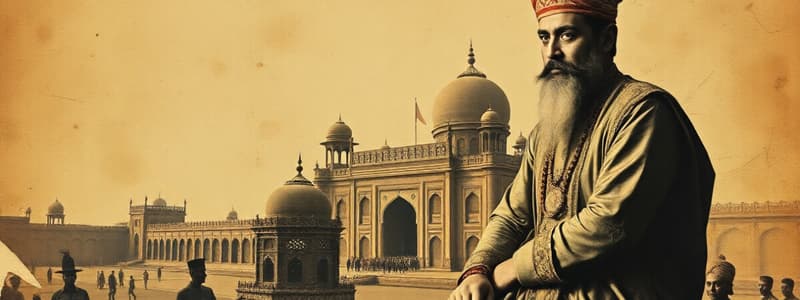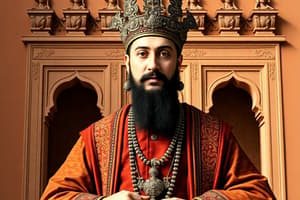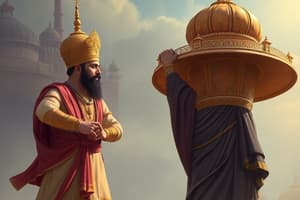Podcast
Questions and Answers
Jahangir deviated from Akbar's policies in which of the following ways?
Jahangir deviated from Akbar's policies in which of the following ways?
- Continuing construction projects.
- Restricting consumption of meat on certain days of the week. (correct)
- Maintaining religious tolerance towards Christians and Hindus.
- Nomination by nobles instead of direct succession.
What was a key challenge Jahangir faced during his reign?
What was a key challenge Jahangir faced during his reign?
- Absence of visits by foreign dignitaries and envoys.
- Unchallenged support from all his step brothers.
- Lack of interest in paintings, musics etc.
- Continuous disputes with Khusrau Mirza. (correct)
What was the primary role of the 'justice bell' in Agra during Jahangir's rule?
What was the primary role of the 'justice bell' in Agra during Jahangir's rule?
- To signal the start of religious ceremonies.
- To mark the changing of the guard at the Agra fort.
- To allow individuals to directly seek justice from the emperor. (correct)
- To alert the public of royal decrees.
Shah Jahan's rule is best characterized by which of the following?
Shah Jahan's rule is best characterized by which of the following?
How did Shah Jahan alter the Mughal state's financial structure?
How did Shah Jahan alter the Mughal state's financial structure?
What was a notable aspect of Aurangzeb's religious policy?
What was a notable aspect of Aurangzeb's religious policy?
Which factor contributed to conflicts during Aurangzeb's reign?
Which factor contributed to conflicts during Aurangzeb's reign?
Which of the following best describes the relationship between the Vijaynagara kingdom and the Delhi Sultanate?
Which of the following best describes the relationship between the Vijaynagara kingdom and the Delhi Sultanate?
What was a significant contribution of Krishna Deva Raya to the Vijaynagara Empire?
What was a significant contribution of Krishna Deva Raya to the Vijaynagara Empire?
How did the Vijaynagara kingdom relate to European powers?
How did the Vijaynagara kingdom relate to European powers?
What was the significance of the Battle of Talikota in 1565 for the Vijaynagara Empire?
What was the significance of the Battle of Talikota in 1565 for the Vijaynagara Empire?
Which of the following best describes the Portuguese impact on India's religious landscape?
Which of the following best describes the Portuguese impact on India's religious landscape?
How did Alfonso de Albuquerque influence Portuguese relations with the native population in Goa?
How did Alfonso de Albuquerque influence Portuguese relations with the native population in Goa?
What was a major factor that led to the decline of Dutch power in India?
What was a major factor that led to the decline of Dutch power in India?
What best describes Dutch trading practices in India?
What best describes Dutch trading practices in India?
How did British East India Company's initial approach to trade differ from that of the Portuguese or Dutch?
How did British East India Company's initial approach to trade differ from that of the Portuguese or Dutch?
What was a key outcome of the Battle of Plassey in 1757?
What was a key outcome of the Battle of Plassey in 1757?
Which of the following was a major factor that contributed to the outbreak of the Carnatic Wars?
Which of the following was a major factor that contributed to the outbreak of the Carnatic Wars?
What was a significant outcome of the Treaty of Paris in 1763 concerning French influence in India?
What was a significant outcome of the Treaty of Paris in 1763 concerning French influence in India?
Which of the following accurately describes the relationship between the Marathas and the Mughal Empire during the 18th century?
Which of the following accurately describes the relationship between the Marathas and the Mughal Empire during the 18th century?
Flashcards
Jahangir's Title
Jahangir's Title
Nassiruddin Mohammad Jahangir, a relatively weak ruler compared to his predecessors.
Jahangir's Religious Policy
Jahangir's Religious Policy
Islam was Jahangir's state religion. He showed tolerance towards Christians and Hindus and banned liquor and tobacco (except for himself).
Jahangir's Justice Bell
Jahangir's Justice Bell
The justice bell in Agra allowed anyone to directly access justice by ringing it.
Aurangzeb's Policies
Aurangzeb's Policies
Signup and view all the flashcards
Aurangzeb's Religious Actions
Aurangzeb's Religious Actions
Signup and view all the flashcards
Vijayanagara's Success
Vijayanagara's Success
Signup and view all the flashcards
Krishnadeva Raya
Krishnadeva Raya
Signup and view all the flashcards
Krishnadeva Raya's Legacy
Krishnadeva Raya's Legacy
Signup and view all the flashcards
Decline
Decline
Signup and view all the flashcards
Portuguese relations
Portuguese relations
Signup and view all the flashcards
Portuguese Goa
Portuguese Goa
Signup and view all the flashcards
Dutch Exports
Dutch Exports
Signup and view all the flashcards
British ambitions
British ambitions
Signup and view all the flashcards
french east India company trade
french east India company trade
Signup and view all the flashcards
Clive.
Clive.
Signup and view all the flashcards
regulating act:
regulating act:
Signup and view all the flashcards
East India administrative system
East India administrative system
Signup and view all the flashcards
Maratha Rise
Maratha Rise
Signup and view all the flashcards
Power
Power
Signup and view all the flashcards
maratha battles
maratha battles
Signup and view all the flashcards
Study Notes
- Nassiruddin Mohammad Jahangir was born to a Rajput princess, Hina Kunwari (Harikaba).
- Nominated by all nobles to be the next Sultan, instead of Akbar's grandson, making him comparatively weak.
- Claimed to establish Islam as the state religion, but was tolerant toward Christians and Hindus.
- Banned consumption of liquor and tobacco for all except himself, and was interested in paintings, music, etc.
- Married Mehrunissa (Noor-e-jahan) in 1611 after the death of her husband, Sher Afghan, in mysterious circumstances.
- Built a justice bell in Agra to allow individuals to directly access the king by ringing it.
- Continued the ban on cow slaughter and restricted consumption of meat on certain days of the week.
- Faced continuous disputes with Khusrau Mirza, who claimed the throne as per Akbar's will.
- Defeated and killed Guru Arjun Dev and Abul Fazl in 1606.
- Visited by Thomas Roe in 1614.
- Endured constant challenges from his step-brother, Murtaza Mirza, and the sons of Daniel Mirza, leaving him a weak ruler.
- In 1627, he died on the way from Kabul in Kashmir due to the winters.
Shah Jahan
- Also known as Khurram Mirza.
- Defeated Shariye in battle to become Sultan, and was supported by Rajputs, particularly the Sisodias of Mewar, because he was the son of Jodha Bai.
- His rule consisted of construction.
- Built Shaljanabad, Lal Qila (Red Fort), and the peacock throne (Taght-e-taus) as well as the Taj Mahal in memory of Mumtaz in 1632.
- Fought the Battle of Hugli in 1632 and defeated the Portuguese, ending their aspirations of an empire.
- The first Mughal to successfully conquer the Deccan with help from his son, Aurangzeb (Alamgir).
- Issued numerous coins and maintained a very rigid state policy.
- Collected taxes without any exemptions, and during his rule, the Mughal state contributed 27% of the world's GDP.
- Destroyed 76 temples in Banaras and numerous temples in Delhi, as mentioned in his own book, Badshahnama.
- In his final days, he fell sick was under the guidance of Dara Shikoh.
- Dara Shikoh claimed to be the son of Mumtaz, while Roshnara and Jahanara were his daughters.
- Murad Bakhsh remained in the northwest, and Aurangzeb remained in the Deccan, resulting in conflict.
- Aurangzeb took over the kingdom by defeating Dara Shikoh in the Battle of Deorai and Samugarh.
- During Shah Jahan's period, Kabul and Kandahar were lost to Persia, and later Punjab was also lost.
- Aurangzeb then regained kingdoms from Kashmir to Punjab.
- Aurangzeb faced problems with the Deccan because he himself was a strict Sunni Muslim and they were Shia.
- Aurangzeb focused on home rule in India from the beginning of year 26 of his reign because he was a strict Sunni Muslim and they were Shia.
- From 1657, "jizya" (tax) and Mahsool Munsifi ( only bolas) were imposed, except that all had to pay.
Vijayanagara Kingdom
- Eemerged as a rebel kingdom during the reign of Mohammad Bin Tughlaq.
- Mohammad Bin Tughlaq forcibly converted two brothers of the Deccan region who were working under a minor kingdom named Kampli.
- Sangama brothers, Harihara Rai and Bukka Rai, founded the city with Vidyanegare, with the blessing of Hindi saint, Vidya Renya.
- Dynasty eventually became known as Vijayanagara Dynasty.
- Had 4 major dynasties
- Sangama (1333-1485)
- Saluva (1485-1505)
- Tuluva (1505 - 1570)
- Aravidu (1570-1650)
- Tuluva dynasty was the most popular and Shri Krishnadevaraya ruled between 1509-1529.
- Shri Krishnadevaraya is known to have promoted Telugu as the primary state language for Vijayanagara.
- He took complete control over Krishna - Tungabhadra doab with the Battle of Diwani and ended the Bahamani challenge.
- Maintained close relations with the Portuguese in Goa through Alfonso de Albuquerque.
- Most powerful king of the Deccan based on Tuzk-e-Babri by Babur. His court was visited by Portuguese travelers Barbossa and Domingo Paes.
- Extensive trade relations existed with Europe
- Telugu book Amuktamalyada was written and maintained by Telugu scholars, ashtadiggajas.
- Tenali Ramakrishna was his advisor in the court.
- Devaraya also wrote 2 Sanskrit books - Jambavati Kalyanam and Ushaparinayam.
- Built Virupaksha temple in Pattadakal and the Tirumala temple was developed.
- promoted the Vaishnava tradition in South, and was succeeded by his brother Achyuta Raya (1529-42).
- During his period, the Tirumala temple was expanded and Carnatic music was further developed.
- The traveler Fernao Nuniz visited his court in 1542.
- After a brief dispute, the kingdom fell into the hands of Sadasiva Raya- nephew.
- Eventually declined and during Sadasiva's period in 1565 with the Battle of Talikota, Deccan Sultans combined forces and attacked the Vijaynagara kingdom.
- During this period Vijaynagara state was looted and in ruins left thampi Vijay nagare as capital remained.
- In 1570, Vijayanagara kingdom moved to Chandragiri region in Andhra and established the Aravidu dynasty, who were later overthrown by the Mless of Mysore & Europeans.
- Major contribution is the development of Deccan Architecture and Dravidian architecture, especially of Temples in South India.
Portuguese Relations
- Great Columbian Trade introduced cashew, jeni (liquor), cabbage, spinach, aloo etc. as well as Pao (used taadi to make it), vada, modra meds.
- 16% of people from Goa sold to Portugal and got citizenship there.
- Much of what we eat today is Portuguese.
- 1st Autopsy by Portuguese
- Portuguese VOC and Estato de Indie (de portuguese) came from a Casa de (East)Albuquerque Indies
- Cabral lost the Battle of Chaul to Portuguese and Arab interests, but made money by loot
- In the Tell, 1961, the Portuguese founded Goa as the capital.
- Almeida was the first to mint coins and established Coachin as capital and maintained sound relations with the Portuguese and neighboring powers, and built a fort with permission from the king.
- Alfonso d' Albuquerque introduced Cartaz to Melace and entered the East China Sea trade route, and made ethnic marriages a goal to get independent ethnic messages.
- Took Goa from Nicom In 1510
- Respected Indian ways & learnt hari
- 1632, Jahangir episode
- Great columbian exchange for goods like pao, panner, Lady canny (dessert).
Dutch
- +90% Julbber Duted companies
- Dutch invented a lot in Indonesia.
- Trade with Kochin built fort
- Dutch palace Buggeti
- Similar to Portuguese at waste only
- Commercialized cotton - trade export to Europe (long cotton), Spice trade - Cinamon, pepper etc.
- Introduced Cartel - gave fermented food like idli, dose, utleppen etc. -noodles, chinese pancakes.
- 1741-Battle of Kuachal - Dutch in Indonesia (Ambonic dispute)
- Dutch defeat by Calicut
- 1759 - Dutch v/s British (Battle of Chinsura) Anglo- Dutch Treaty - no interfere
- Dutch in Sri Lanka - Dilma tea Company-Dutch sold Sri Canka to British ( 1946) India-Indonesia foreign Relation(Sukerro-Biju Patrayat)
British East Indian Company (EIC)
- Company set to give taxes
- East India company
- Merchant owned company
- 1610- Red dragon ship-William Hawke
-
- Thomas Roe (knew persian, 2 beer, 2 paintings,
- 1612 - Portuguese Is Dutch
- Battle of swalikoht Surat
- Francis day merchant lease by Raja Chandragiri. Chennai, (Machas). East India company 3000 Rs. tax per year ,Saint George 1639 artificial
- 1661- Charles & Portuguese queen (dowry of island Bombal
Alfonso De Albuquerque
- 2nd viceroy
- Albuquerque, encouraged Portuguese to marry Indians and occupied Malacca.
- Also introduced Cartes for trade and was succeeded by weak generals.
- From 1554, forceful conversion to Christian ships in world and in 1632, India under Shah Jahar restricted too Coast.
- Trade consisted of cotton, spice, and non-precious metals
- 166Princess Caming to marriage and by that brought Indian wealth.
###Dutch East India Company (VOC)
- The company began In 1602 by Comolius de Hautman with Indian stock joints.
- East India Company.
- In1605 leased first tactory.
- Pulikat company later it was capital of Nagapatinam, In 1609 the 1st Company
- Involved in spice, replite and rubber plantation
- The company large scale involved in fori Gerldriain,Puliked
- They East India and it existed East India Company (174Dutch) but were British
Robert Clive
- Clive was appointed as governor and got rich in the midst of such tragedy
- India 175 After blackhold tragedy.
- Clive East became rich East and had to manage from then and his rich became of
- Robert Robert East He East Robert, In1758,Robert Clives made an Indian East .he East Robert gave East , the 1769 Robert was rich. Robert .Robert 1774"
Studying That Suits You
Use AI to generate personalized quizzes and flashcards to suit your learning preferences.




